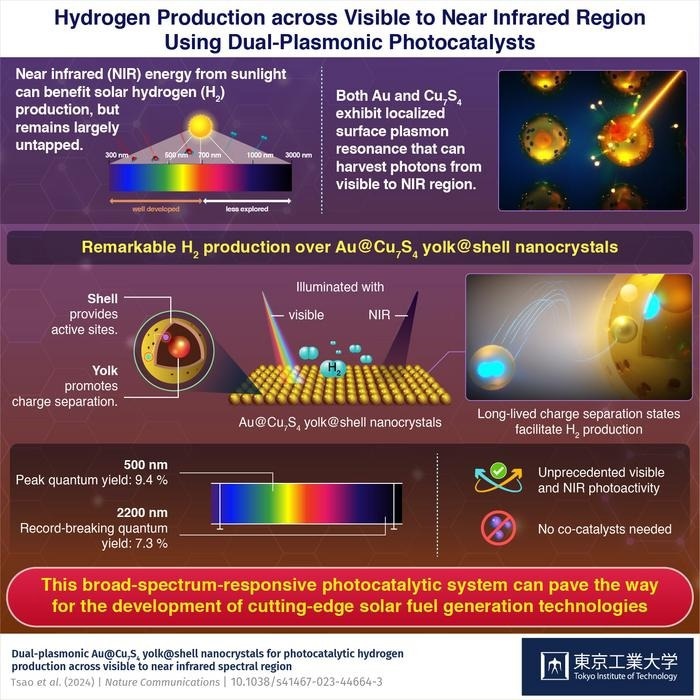Reviewed by Lexie CornerFeb 28 2024
The spectrum of wavelengths of sunlight that reaches Earth ranges from ultraviolet to visible to infrared. Every wavelength has intrinsic energy that, when used wisely, could significantly boost solar hydrogen production and reduce dependency on nonrenewable energy sources.
 This broad-spectrum-responsive photocatalytic system can pave the way for the development of cutting-edge solar fuel generation technologies. Image Credit: Tokyo Tech
This broad-spectrum-responsive photocatalytic system can pave the way for the development of cutting-edge solar fuel generation technologies. Image Credit: Tokyo Tech
However, current solar hydrogen production methods are limited in their ability to harness the full potential of near-infrared (NIR) light energy reaching Earth due to the constrained ability to absorb light over this wide spectrum.
According to recent studies, localized surface plasmon resonance (LSPR), a unique optical property, is present in both Au and Cu7S4 nanostructures. It is highly adjustable to absorb visible to near-infrared wavelengths.
An innovative Au@Cu7S4 yolk@shell nanocrystal that can produce hydrogen when exposed to both visible and NIR light was created by a team of researchers led by Professor Yung-Jung Hsu from National Yang Ming Chiao Tung University, Associate Professor Tso-Fu Mark Chang, and Lecturer Chun-Yi Chen from Tokyo Institute of Technology.
This research was published in Nature Communications on January 9th, 2024, their
Dr. Hsu and Dr. Chang stated, “We realized that wide-spectrum-driven hydrogen production is gaining momentum in recent days as a potential green energy source. At the same time, we saw that there were not many currently available options for photocatalysts that could respond to NIR irradiation. So, we decided to create one by combining two promising nanostructures, i.e. Au and Cu7S4, with tailorable LSPR features.”
The Au@Cu7S4 nanocrystals were synthesized by the research team using an ion-exchange reaction, and their structural and optical properties were then examined using high-resolution transmission electron microscopy, X-Ray absorption spectroscopy, and transient absorption spectroscopy.
The results of these studies verified that Au@Cu7S4 has a yolk@shell nanostructure and dual-plasmonic optical characteristics. Additionally, Au@Cu7S4’s potential for effective solar energy conversion was highlighted by ultrafast spectroscopic data, which showed that it sustained long-lived charge separation states when exposed to both visible and NIR light.
The research team found that the Au@Cu7S4 nanocrystals’ intrinsic yolk@shell nanostructures significantly improved their photocatalytic properties.
The confined space within the hollow shell improved the molecular diffusion kinetics, thereby augmenting the interactions among reactive species. Additionally, the mobility of the yolk particles played a crucial role in establishing a homogeneous reaction environment, as they were able to agitate the reaction solution effectively.
Chun-Yi Chen, Lecturer, Tokyo Institute of Technology
As a result, this novel photocatalyst produced hydrogen at a record-breaking quantum yield of 7.3 % in the NIR range (2200 nm) and a peak quantum yield of 9.4 % in the visible range (500 nm). Interestingly, this new method does not require co-catalysts to boost hydrogen generation processes unlike traditional photocatalytic systems.
The study presents a novel sustainable photocatalytic technology for solar fuel production that exhibits exceptional hydrogen production capabilities and broad-spectrum light sensitivity. It demonstrates how the LSPR characteristics of Au and Cu7S4 can effectively collect NIR energy that has yet to be discovered.
“We are optimistic that our findings will motivate further investigations into tweaking the LSPR properties of self-doped, nonstoichiometric semiconductors, aiming to create photocatalysts responsive across a wide spectrum for a variety of solar-powered applications,” Dr Hsu and Dr Chang concluded.
Journal Reference:
Tsao, C.-W., et. al. (2024) Dual-plasmonic Au@Cu7S4 yolk@shell nanocrystals for photocatalytic hydrogen production across visible to near infrared spectral region. Nature Communications. doi:10.1038/s41467-023-44664-3